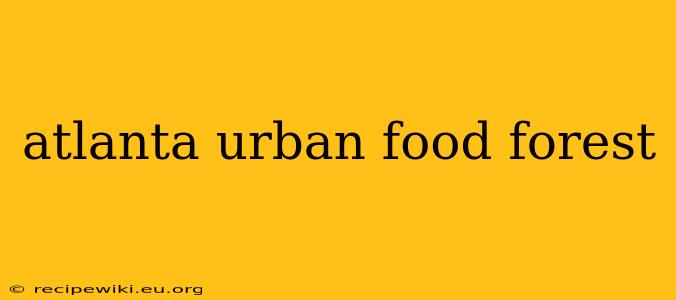Atlanta is experiencing a blossoming revolution in its approach to food security and environmental sustainability: the rise of urban food forests. These aren't your typical forests; they're carefully planned ecosystems designed to produce a variety of edible plants, fostering community engagement and ecological restoration within the city limits. This article delves into the fascinating world of Atlanta's urban food forests, exploring their benefits, challenges, and the vibrant community driving this impactful movement.
What is an Urban Food Forest?
Unlike traditional orchards or farms, an urban food forest mimics the structure and diversity of a natural forest ecosystem. Instead of rows of single-crop plantings, food forests incorporate a multitude of species – fruits, nuts, vegetables, herbs, and mushrooms – creating a resilient and productive landscape. These forests are designed to be self-sustaining, minimizing the need for external inputs like fertilizers and pesticides. Key elements include:
- Guild Planting: Strategically grouping plants that benefit each other, such as nitrogen-fixing plants that enrich the soil for other species.
- Vertical Layering: Utilizing different plant heights to maximize space and sunlight utilization, mirroring the natural layers of a forest.
- Permaculture Principles: Employing ecological design principles to create a harmonious and productive system.
The Benefits of Atlanta's Urban Food Forests
The impact of urban food forests extends far beyond the production of food. They offer a multitude of benefits to Atlanta and its residents:
- Increased Food Security: Providing access to fresh, healthy food in underserved communities, combating food deserts and promoting nutritional well-being.
- Environmental Sustainability: Improving air and water quality, reducing carbon emissions, and enhancing biodiversity within the urban landscape.
- Community Building: Creating spaces for social interaction, education, and collaborative action, fostering a sense of community ownership and pride.
- Educational Opportunities: Serving as living classrooms for learning about ecology, permaculture, and sustainable food systems.
- Economic Opportunities: Providing potential avenues for local businesses and entrepreneurs involved in food production and related services.
Challenges and Opportunities
Despite the numerous benefits, developing and maintaining urban food forests in Atlanta presents certain challenges:
- Land Access: Securing suitable land within the city limits can be difficult and expensive.
- Funding and Resources: Establishing and maintaining a food forest requires significant investment in labor, materials, and ongoing management.
- Community Engagement: Sustained community participation is essential for the long-term success of these projects.
- Pest and Disease Management: Protecting the plants from pests and diseases requires careful planning and monitoring.
However, these challenges are also opportunities for innovative solutions and collaborative partnerships. The growth of the urban food forest movement in Atlanta highlights the city's commitment to sustainability and community well-being.
Getting Involved in Atlanta's Urban Food Forest Movement
Numerous organizations and initiatives are working to establish and expand urban food forests throughout Atlanta. By engaging with these groups, individuals can contribute to this exciting movement, learn more about sustainable food systems, and become active participants in building a greener, healthier Atlanta. Look for local volunteer opportunities and educational workshops to connect with the growing community.
Keywords: Atlanta urban food forest, urban farming, sustainable agriculture, community gardens, food security, permaculture, Atlanta green spaces, ecological restoration, environmental sustainability, community engagement, food deserts, edible plants.
